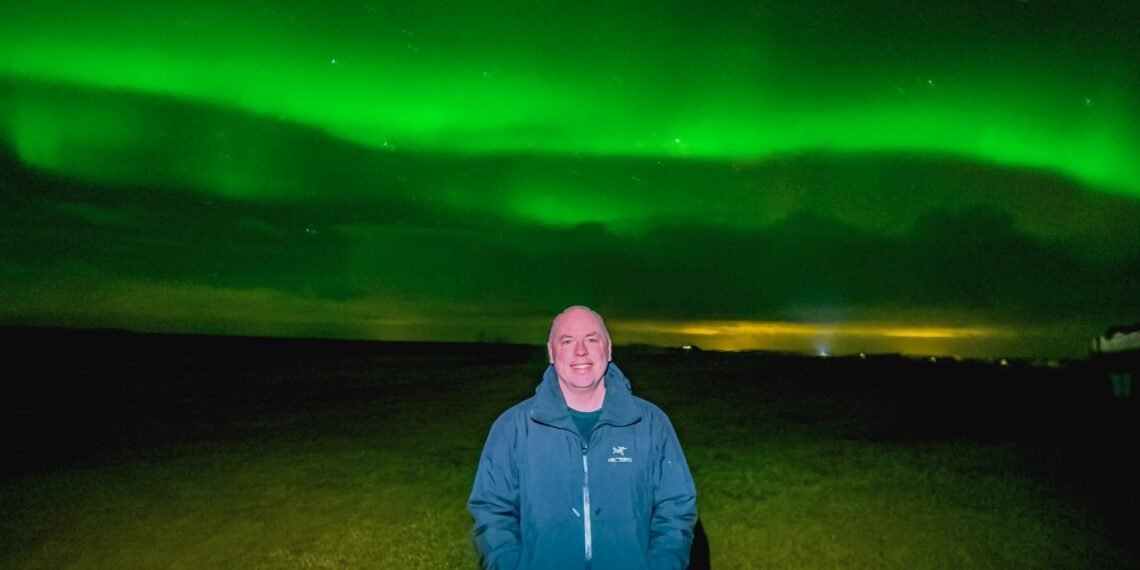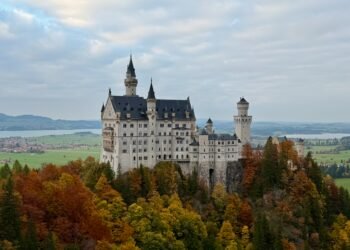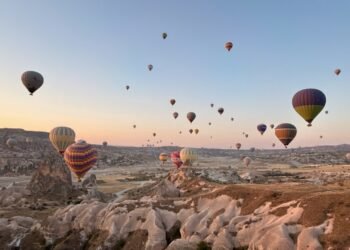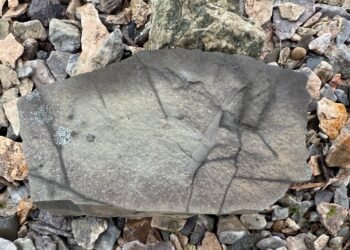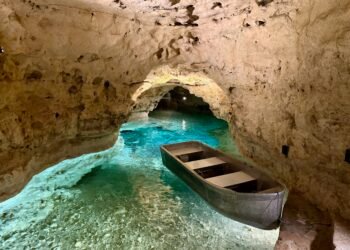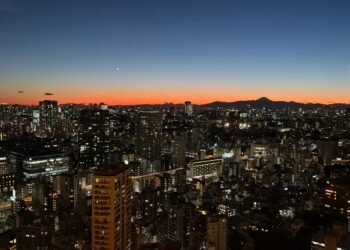I arrived in Iceland with vivid memories of the auroras I once saw in my Canadian hometown. Determined to capture that wonder again, I explored Reykjavík, Rangárping Eystra, and Flóahreppur—armed with my iPhone 16 Pro Max and weather forecasts galore. Through high winds and late nights, I hunted the elusive glow of the Iceland Northern Lights. In this article, I’ll share my firsthand experiences, reveal the fascinating science behind the aurora, and offer practical tips so you can embark on your own skyward quest.
Disclosure: Some of the links in this article are affiliate links, which means I may earn a small commission—at no additional cost to you—if you book or purchase through them. Rest assured, I only recommend places or services I’ve personally tried and enjoyed.
1 Aurora Nostalgia: From Childhood Wonder to Icelandic Quest
I remember the first time I truly became aware of the cosmic dance we call the Aurora Borealis. It was the late 1980s in my hometown in the Canadian province of New Brunswick. One cold winter’s evening, the sky erupted into ribbons of shimmering green and pink so intense that it felt as if someone had switched on a giant neon display in the sky above me. The night sky, usually dark and mysterious, was transformed into a radiant performance that left me speechless. It was so brilliant that night, you could almost read a book by its glow. Even as a child, I understood I was witnessing something extraordinary—something that seemed halfway between science and magic.

Now, decades later, I found myself in Iceland, a place often touted as one of the best destinations on Earth to witness the Northern Lights. With its proximity to the Arctic Circle, Iceland is frequently under auroral arcs during winter months. I was visiting in February, a time of year that typically offers long nights and relatively favorable conditions for Iceland Northern Lights chases. While there, I also made time to explore other stunning sights, including the dramatic Sólheimajökull Glacier, before continuing my aurora quest. Of course, “favorable” is a complicated word when it comes to Iceland. The island, touched by the warm waters of the Gulf Stream, has notoriously fast-changing weather that doesn’t always align with even the best aurora forecasts. Despite this, I arrived with unwavering determination—and a simple iPhone 16 Pro Max in hand—to photograph and marvel at one of nature’s most mystical displays.
2 Iceland Aurora Essentials: Quick Facts for Curious Minds
- Location & Latitude: Iceland sits between 63° and 66° N, placing much of the country under prime auroral territory.
- Best Viewing Season: The Iceland Northern Lights are most visible from late September through April, when nights are longest.
- Winter Temperatures: Even in February, Iceland’s coastal regions hover around 0°C to 3°C (32°F to 37°F), though wind chill can make it feel much colder.
- Weather Swings: Thanks to the Gulf Stream, Iceland’s climate shifts rapidly—clear skies can turn to drizzle in minutes.
- Aurora Forecast: Websites and apps like Vedur.is provide real-time cloud cover and aurora activity updates, essential for planning your nightly hunts.
- Photography Gear: Many modern smartphones (like the iPhone 16 Pro Max I used) now have Night Mode settings capable of capturing the aurora. A small tripod or phone stabilizer can vastly improve your shots.
- Rural vs. Urban Viewing: Even mild light pollution can affect visibility, so driving just a few miles outside major towns or cities can significantly enhance your aurora experience.
3 Setting the Stage: Understanding the Aurora Borealis
Before diving into the day-to-day account of my Icelandic adventure, allow me to share a bit about the science of the Aurora Borealis. Growing up, I was always fascinated by Earth science, so I understood that the Aurora stemmed from solar wind interacting with Earth’s magnetic fields. As an amateur radio operator, I also became familiar with how our Sun influences everything from auroral activity to radio wave propagation—and I was eager to witness that cosmic interplay again on this trip.
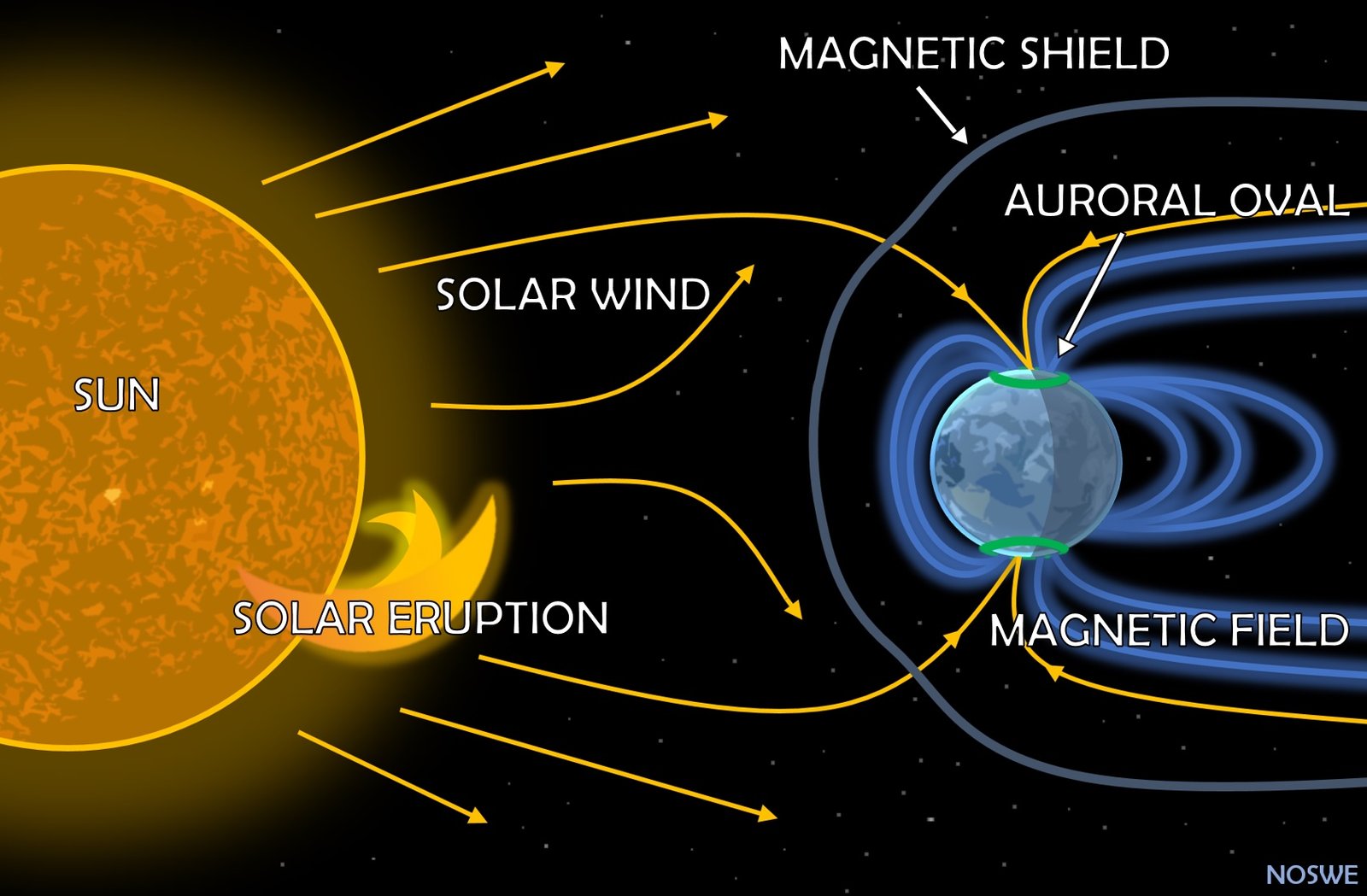
The short version is this: Our Sun emits a constant stream of charged particles, known collectively as the solar wind. When this solar wind collides with Earth’s magnetic field, some of these charged particles are funneled toward our planet’s magnetic poles. As these particles interact with atoms and molecules in our upper atmosphere—chiefly oxygen and nitrogen—they excite these atoms, causing them to release photons (light) in the process. The color of the light depends on which gases are being excited and at what altitude. Oxygen at higher altitudes tends to produce a greenish glow, while nitrogen can yield pinkish or purple hues.
Moreover, solar activity waxes and wanes in approximately 11-year cycles. When I visited Iceland, the year was 2025, a period where the number of sunspots had been on the rise, inching toward a solar maximum. This meant more intense solar winds and, in theory, a higher likelihood of strong auroral displays. However, even strong auroral activity needs a bit of luck with weather—particularly cloud cover. If the skies are thick with clouds, the greatest auroral activity can go completely unseen.
In Iceland’s case, the tumultuous North Atlantic weather systems mean it’s entirely possible to have a glorious solar storm overhead while you stand in an unrelenting downpour with zero visibility. I prepared myself for a game of cat and mouse, scouring the cloud maps and aurora forecasts in hopes of finding a perfect window of clear sky and solar activity.
4 Day 1 – Reykjavík: A Cloudy Start
I touched down in Reykjavík to a brisk February wind and the gentle hum of the city’s colorful buildings. I picked up my rental car—a sturdy little vehicle that would become my faithful companion—and headed for the city center. Despite Iceland’s reputation for sparse population and endless natural wonders, its capital felt cozy, especially in winter. My first night was spent at CityHub Reykjavik, a modern, budget-friendly hotel right near the waterfront and the famous Sculpture and Shore Walk. It was around 9 p.m. when I made my way there, and my heart beat with anticipation. Could I see the aurora dancing above the urban lights?
Unfortunately, thick clouds had decided to settle in just as the aurora forecast predicted a moderate storm. Even with the artificial glow from the city, I scanned the sky for any flicker of green but was met with a swirling gray ceiling of clouds. I lingered by the waterfront for a while, listening to the waves, feeling the chill settle into my bones, and hoping for any sign of change. But the clouds didn’t budge.
Despite my disappointment, Reykjavík’s evening had a charm all its own. Streetlights reflected off the puddles, casting a warm glow over the sidewalks. Warm coffee shops beckoned, and the famous Harpa Concert Hall shimmered with its own light show. I decided to set aside my aurora quest for the night, telling myself that this was just the beginning of the journey. Iceland was known for its weather mood swings, and I was hopeful tomorrow would bring better luck.
5 Day 2 – Hellishólar: Battling Winds and Clouds
The next day, I headed out of Reykjavík into the countryside of Rangárping Eystra. Driving in Iceland is an adventure in its own right. Sweeping vistas of snowy fields, towering waterfalls like Seljalandsfoss and Skógafoss, and steaming geysers dotted the landscape. Each stop along the way reminded me that, aurora aside, Iceland is a feast for the senses.

As evening approached, I obsessively checked both the aurora forecast and local cloud cover map. A glimmer of hope emerged: around 9 p.m., the aurora might be near a peak, and there could be a small break in the clouds by 10 p.m. So I ventured out, leaving the cozy interior of my hotel in Hellishólar, Hótel Eyjafjallajökull, which I chose for its scenic farmland setting and comfortable rooms. I headed down a remote farm road with minimal light pollution, hoping for a break in the weather.
As soon as I stepped out of the car, I was nearly knocked off my feet by the furious Icelandic wind. The car itself swayed and lurched, buffeted by relentless gusts. Holding my iPhone 16 Pro Max steady for a long-exposure photo felt like wrestling a small dragon. Still, I was determined.

Peering at the sky, I noticed a soft green glow filtering through the moving clouds. It was as if a secret aurora show was taking place above a curtain of gray and white. Every once in a while, the cloud cover thinned just enough to reveal that the aurora was indeed active—like a backstage glimpse of the real performance. I snapped a few photos, capturing the eerie green illumination of the clouds. Even if it wasn’t the full kaleidoscope I yearned for, it was magical in its own, teasing way.

I stayed until nearly midnight, buffeted by wind and drizzle. Occasionally, stars winked into view, hinting that a true aurora spectacle might break out at any moment. But as the minutes ticked by, the cloud gap never fully materialized, and the wind only grew stronger. Eventually, I surrendered to the elements, climbed back into the car, and returned to my hotel, feeling a mixture of awe and frustration. That night, I fell asleep still listening to the wind’s roar outside my window.
6 Day 3 – Lindartún: A Brief Window of Clarity
The next morning was filled with more exploration of Iceland’s geological wonders. Even when you’re not aurora-hunting, there’s a singular thrill to seeing the dramatic landscapes shaped by volcanic activity and ancient glaciers. By the time I arrived back at my guesthouse, Lindartún Guesthouse, around 7 p.m., it had been raining most of the day, and the sky remained stubbornly overcast. I’d picked Lindartún for its friendly hosts and serene countryside location—ideal for stargazing when the weather cooperates.
After dinner, I checked outside around 9 p.m. purely out of habit. To my immense surprise, the clouds had parted, revealing a star-speckled sky. Better yet, I could see a faint green streak overhead! Excited, I grabbed my keys, hopped into the rental car, and drove down another rural road to escape any local light pollution from the guesthouse.

For about an hour, I stood by a field, bracing myself against the cold. The aurora was definitely there, but it was subdued—a gentle haze of green without the vivid intensity I’d witnessed decades ago in New Brunswick. Nonetheless, I snapped photos with my iPhone, fiddling with the camera’s night mode and trying different angles and exposure times. Even at its faintest, the aurora carries a certain otherworldly beauty that is hard to describe.
By 11:30 p.m., clouds had regrouped, snuffing out the faint green glow. The entire sky gradually faded into darkness again. Although this display wasn’t as dramatic as I had hoped, I felt a renewed sense of optimism—if the clouds could part once, maybe they would do so again. I went to bed that night thinking about the ephemeral nature of the aurora. It’s unpredictable, elusive, and fleeting, and yet that is precisely what makes it so enchanting.
7 Day 4 – Vík: Raining Cats and Dogs
After a full day of exploring around Vík—including a breathtaking stop at the Sólheimajökull Glacier—the rain set in and refused to let up. With the sky fully draped in clouds, any hopes of chasing the Northern Lights that evening went out the window. I decided to check into Guesthouse Carina, a cozy spot in Vík that offered a much-needed refuge from the relentless rain. Settling in for the night, I was grateful for the warmth and dryness after a long stretch of wet, windswept adventures and sightseeing.
8 Day 5 – Vatnsholt: A Midnight Knock and a Spectacular Show
On my fifth day, I arrived at Guesthouse Vatnsholt around 8:30 p.m., tired but content from a full day of sightseeing. I had soaked in one of Iceland’s many natural hot springs earlier, an experience that left me wonderfully relaxed. Upon checking in, I discovered the guesthouse had a WhatsApp group dedicated to alerting guests when the aurora became visible—a clever idea for nighttime sky-watchers.
Exhausted from the day’s excursions, I retreated to my room and promptly fell asleep. Sometime around 11:30 p.m., I heard a faint knock on my door. I vaguely remember stirring but not fully waking up. In a half-asleep daze, I ignored it. It wasn’t until a few minutes later that I scrambled to the window, and lo and behold, there it was—the aurora in all its splendor, dancing across a crystal-clear sky. I threw on my warm clothes in record time and practically sprinted outside. Behind the building, away from the soft glow of porch lights, I could see a magnificent display. Bright green curtains rippled and pulsed, intermingling with hints of pink along their edges. In that moment, I felt as though the night sky had come alive solely for my benefit.

I began snapping photos with my iPhone, marveling at how far smartphone camera technology had come. The night mode settings allowed me to capture surprisingly detailed shots—streaks of green and pink shining vividly, stars peppered across the background. The temperature hovered around freezing, but I hardly noticed the cold. I was too enthralled by the silent, cosmic performance overhead.
Unsatisfied with the faint glow of the guesthouse lights, I decided to drive a short distance along a secluded country road. Parking the car near an empty field, I stepped out into near-total darkness. That’s when the aurora truly revealed its grandeur. Pulses of light seemed to shimmer and sway in sync with my heartbeat. From horizon to horizon, the sky was adorned with delicate patterns that shifted shape in fluid, hypnotic motion. I watched, transfixed, for what felt like both a fleeting second and an eternity all at once.

Every so often, gentle pink fringes surfaced around the edges of the green curtains. These are associated with molecular nitrogen emissions, and they’re more rare to spot than the predominant green from atomic oxygen. Witnessing that pink was like a bonus gift from the cosmos. It evoked the memory of that 1980s display in New Brunswick, making me feel like the circle of my aurora journey was finally complete.
For about an hour, I was enveloped in this ethereal glow. As with all good things, the show eventually began to diminish. Clouds, never too distant in Iceland, inched their way back across the sky, gradually muting the shimmering lights. By the time the celestial curtains faded, I felt a deep sense of fulfillment. I’d come all this way with uncertain weather forecasts and the simplest of camera gear, and I’d been rewarded with an absolutely glorious spectacle.
9 Practical Travel Tips
Here are some practical tips I learned in Iceland that can help you navigate everything from lodging to late-night aurora hunts.
- Timing is Everything: The Iceland Northern Lights are most easily seen between late September and early April. I chose February because of the long nights, but keep in mind that weather is a huge variable. Aim to stay at least a week if possible; having multiple nights drastically increases your chances of spotting a display.
- Keep an Eye on Forecasts: Regularly check both the aurora forecast (which will often be given on a 0-9 “Kp index” scale) and local cloud cover. Websites and apps can provide hour-by-hour cloud cover projections, which are crucial in Iceland’s fast-changing climate.
- Stay Flexible with Your Itinerary: If you can, keep your schedule open-ended. When you see a favorable window for auroras, be willing to drop other plans to chase clear skies.
- Choose Accommodations Wisely: Seek out guesthouses or hotels that offer Northern Lights wake-up calls or alert systems. They can make all the difference if the lights appear while you’re sleeping.
- Dress Warmly and Windproof: Icelandic wind can be ferocious. Layer up with thermal underwear, waterproof and windproof outer layers, and don’t forget gloves, hats, and insulated boots.
- Driving Tips: If you plan to rent a car, familiarize yourself with Icelandic road conditions. Roads can be icy, and sudden weather changes can make driving challenging. Check road condition websites daily, especially in winter, and opt for a 4×4 if you’re venturing off major highways.
- Embrace Other Icelandic Wonders: Remember, even if the aurora decides to hide, Iceland itself is brimming with stunning waterfalls, geysers, hot springs, and glaciers. You won’t run out of things to do.
10 Pro Tips for the Science Traveler
If you’re eager to delve deeper into the nitty-gritty of aurora science and refine your observation techniques, these specialized tips will help you get the most out of your journey.
- Understand Solar Cycles: If possible, try planning your trip near a solar maximum, which occurs roughly every 11 years. During solar max, sunspot activity is at its highest, offering more frequent and intense auroral events. 2025 is near a predicted peak, but even within that general timeframe, timing your trip to an active solar period can help.
- Simplify Your Gear: Contrary to popular belief, you don’t need top-of-the-line DSLR or mirrorless cameras to capture the Aurora. Modern smartphones, particularly in “Night Mode,” can do a surprisingly good job. The iPhone 16 Pro Max I used is a testament to that. However, for the best results, consider a stable tripod or phone holder to minimize blur from hand-shake.
- Dive Deeper into the Physics: Before your trip, read up on how charged particles interact with Earth’s magnetosphere and atmosphere. Understanding the scientific backstory can enrich your viewing experience. When you see the pink edges of an aurora, you’ll know it’s nitrogen at play, adding to the wonder of the phenomenon.
- Track Solar Flares and Coronal Mass Ejections (CMEs): NASA and various space-weather prediction centers track solar flares and CMEs in near real-time. A strong CME heading toward Earth can dramatically heighten auroral intensity. Subscribing to space-weather alerts can give you a heads-up for potentially spectacular displays.
- Collect Data and Share: If you’re scientifically inclined, you might bring along basic magnetometer apps (available on some phones or devices) to track changes in Earth’s magnetic field during an auroral event. Sharing your data with citizen-science projects can help researchers map auroral activity in greater detail.
- Compare Northern and Southern Hemispheres: The Aurora Borealis has a southern counterpart called the Aurora Australis. If you’re a true science nomad, consider chasing the lights in both hemispheres for a full picture of this global phenomenon.
11 Reflections on the Aurora Experience
Each evening I went out under the Icelandic sky felt like opening a mystery box. Would there be a glorious light display waiting for me, or would it be more rain, wind, and overcast skies? In those days of waiting and watching, I felt connected not just to Iceland’s land and weather, but also to our dynamic Sun over 90 million miles away.
The Northern Lights have a subtle power; they provoke curiosity and wonder. Standing in a dark field, peering up at swirling lights, you become acutely aware of how everything in the cosmos is interconnected. A solar flare ignites, ejecting charged particles. Days later, those particles slam into Earth’s magnetosphere. Our planet’s defenses steer them into polar skies, where their collisions with atmospheric atoms unleash flashes of colorful brilliance.
Witnessing that brilliance firsthand is humbling. It reminds you that Earth is not an isolated bubble but part of a vast, energetic solar system. I couldn’t help but feel a certain kinship with the early humans who must have gazed up at the aurora with equal parts awe and terror, inventing myths about gods and spirits dancing in the sky. Even now, with the gift of scientific understanding, the aurora retains its mythic quality.
I also found myself reflecting on how fleeting and precious these moments are. Modern life can be hectic, tethering us to screens and schedules. Yet the aurora remains elusive, forcing you to relinquish control and simply wait—often in cold, dark places—for nature to unveil its masterpiece. There’s a beauty in that surrender. It’s a reminder that not everything in life can be orchestrated or predicted.
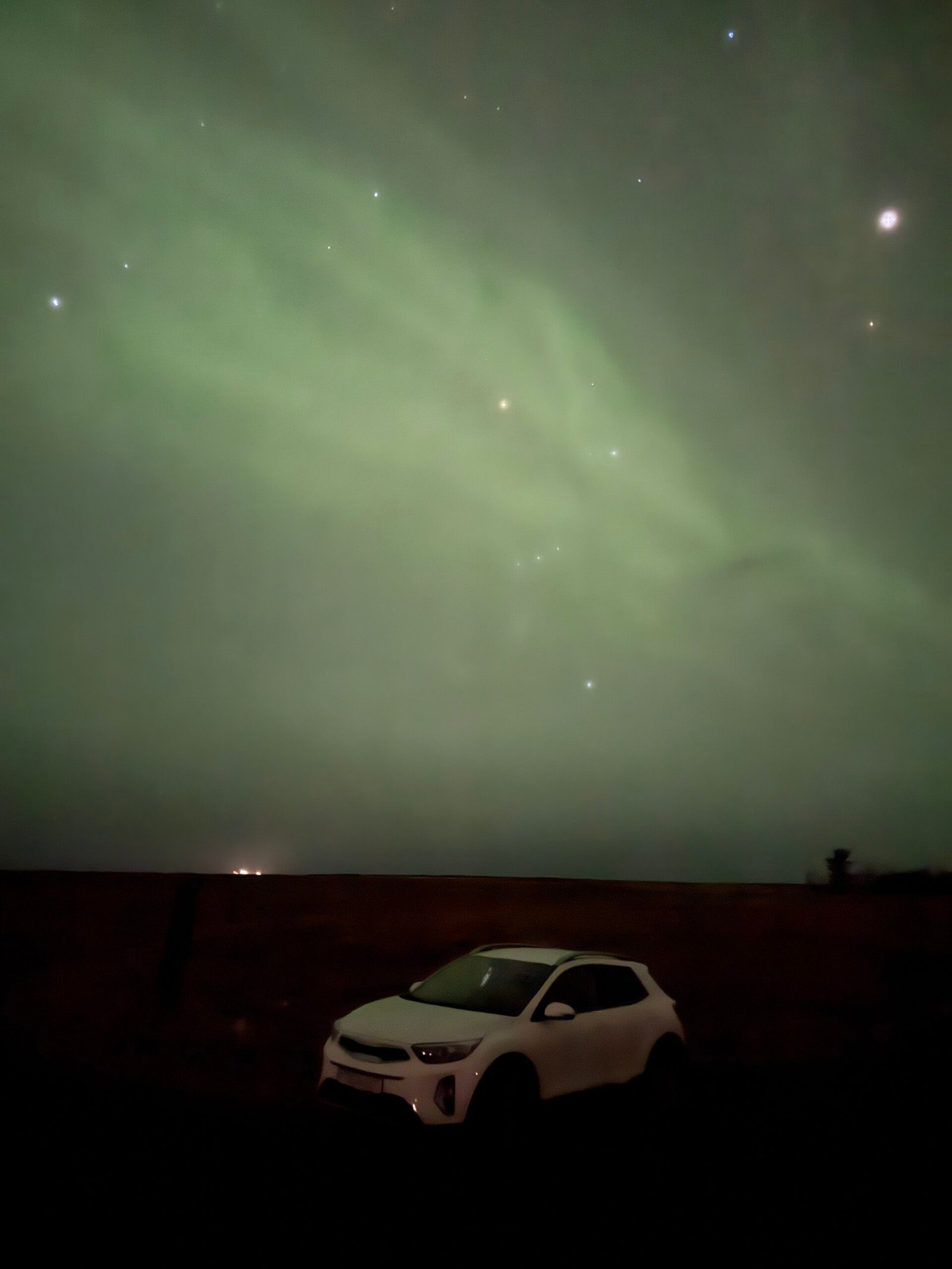
12 Conclusion
My Icelandic aurora adventure ended on a high note, thanks to that midnight knock on my door and the luminous display that followed. I still recall the delight of stepping outside into the crisp Icelandic air, glancing up, and seeing the sky alight with rolling waves of green and pink. Those precious minutes under a dancing sky made all the windblown frustration and nights of clouded disappointment worthwhile.
In the weeks since returning home, I’ve spent hours poring over the photos on my phone. Each image is a window back to that hour of celestial wonder, capturing the cosmic interplay of solar and terrestrial forces. I’m struck by how a phenomenon that arises from the physics of charged particles can be so profoundly emotional in its impact.

For travelers considering the same quest, I say go for it. Embark on your own northern lights chase, whether in Iceland or beyond. Yes, there are risks—the weather might not cooperate; the aurora might be faint—but the possibility of witnessing the sky come alive with color is well worth it. There’s something about seeing those lights that simultaneously connects you to ancient legends, modern science, and the simple, pure thrill of discovery.
In the end, the Aurora Borealis is more than just a pretty sky show—it’s an encounter with Earth’s place in the solar system, a brush with the Sun’s far-reaching influence, and a testament to the ever-present dance of nature’s forces. And if you’re lucky enough to find yourself under a cloudless Icelandic sky at the right moment, you may find that no words, no photos, and no scientific explanation can fully capture the deep sense of wonder that overcomes you.
Until my next aurora chase—whether it’s here in Iceland, my hometown in New Brunswick, or somewhere else entirely—I’ll cherish the memory of those shimmering lights that graced one magical February night under the endless northern sky.
13 Where I Stayed: Recommended Accommodations
Here are the places I called home throughout my Iceland Northern Lights chase. I’ve included a quick rundown of what makes each spot special. (Note: These are affiliate links, meaning I may earn a small commission—at no extra cost to you—if you decide to book through them.)
- CityHub Reykjavik
- Why I Liked It: Modern, budget-friendly concept with a super-central location and easy access to Reykjavík’s major attractions. Great for meeting fellow travelers in the communal areas.
- Check Availability: CityHub Reykjavik
- Hótel Eyjafjallajökull
- Why I Liked It: Comfortable rooms in a scenic countryside setting, perfect for aurora hunting when the skies clear. A cozy retreat after a day of exploring Iceland’s majestic waterfalls and geysers.
- Check Availability: Hótel Eyjafjallajökull
- Lindartún Guesthouse
- Why I Liked It: Friendly hosts, serene environment, and a good vantage point for stargazing in Rangárping Eystra. Ideal if you want a quiet, homey base for your travels.
- Check Availability: Lindartún Guesthouse
- Guesthouse Carina
- Why I Liked It: A cozy spot right in Vík, making it a convenient jump-off point for exploring Sólheimajökull Glacier. Offers a warm respite on those wet and windy Icelandic nights.
- Check Availability: Guesthouse Carina
- Guesthouse Vatnsholt
- Why I Liked It: Located in a peaceful stretch of countryside, it’s perfect for late-night aurora alerts thanks to their handy WhatsApp group. Plus, the rural surroundings keep light pollution to a minimum.
- Check Availability: Guesthouse Vatnsholt
These options gave me a chance to experience both Iceland’s city life and rural charm. Whichever you choose, you’ll be well-positioned to explore the land of fire and ice—and hopefully witness those enchanting Northern Lights dancing overhead.

